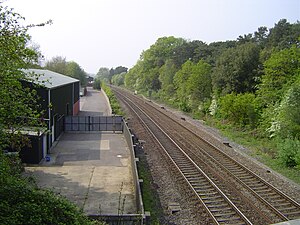The year 1845 in architecture involved some significant architectural events and new buildings.

Coalpit Heath is a small village in the parish of Westerleigh, South Gloucestershire, England, south of Yate and east of Frampton Cotterell in South Gloucestershire.

The South Wales Main Line, originally known as the London, Bristol and South Wales Direct Railway or simply as the Bristol and South Wales Direct Railway, is a branch of the Great Western Main Line in Great Britain. It diverges from the core London-Bristol line at Royal Wootton Bassett beyond Swindon, first calling at Bristol Parkway, after which the line continues through the Severn Tunnel into South Wales.
The Bristol and Gloucester Railway was a railway company opened in 1844 to run services between Bristol and Gloucester. It was built on the 7 ftBrunel gauge, but it was acquired in 1845 by the 4 ft 8+1⁄2 instandard gauge Midland Railway, which also acquired the Birmingham and Gloucester Railway at the same time.
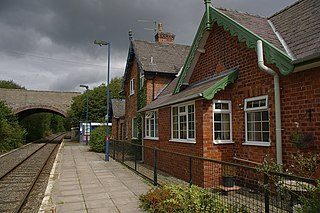
Hopton Heath railway station in Hopton Heath, Shropshire, England, lies on the Heart of Wales Line, 25+1⁄2 miles (41.0 km) south west of Shrewsbury.
The Cheltenham and Great Western Union Railway was a railway company intended to link Cheltenham, Gloucester and Swindon, in England. It was authorised in 1836 but it found it very hard to raise money for the construction, and it opened only a part of its line, between Swindon and Cirencester, in 1841. It sold its business to the Great Western Railway, which quickly built the line through to Gloucester in 1845 and Cheltenham in 1847; part of that route was shared with other companies.
Wednesfield Heath railway station was a station built on the Grand Junction Railway and opened on 4 July 1837 as Wolverhampton. It was the first railway station serving the town of Wolverhampton, and was located around a mile to the east of the city centre within the suburb of Heath Town, on Station Road. It was designated as a First Class station.
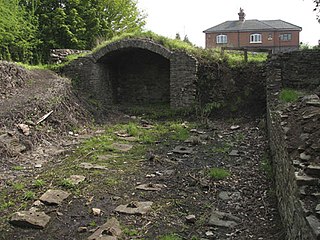
Ram Hill Colliery, was a privately owned colliery in the Coalpit Heath area north-east of Bristol, England. It operated between about 1825 and 1865.
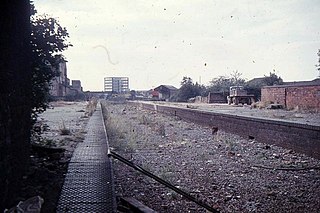
Fishponds railway station was a station in Fishponds, Bristol, England, a victim of Dr Beeching's cuts in the 1960s.

Tenterden Town railway station is a heritage railway station on the Kent and East Sussex Railway in Tenterden, Kent, England.
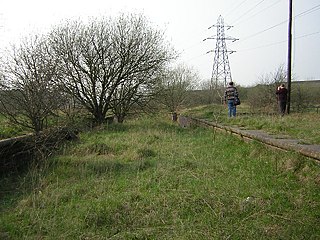
Staveley Works railway station was on the outskirts of the town of Staveley, Derbyshire.

Henfield is a hamlet in South Gloucestershire, England between Coalpit Heath and Westerleigh, adjoining the hamlet of Ram Hill immediately to the north.
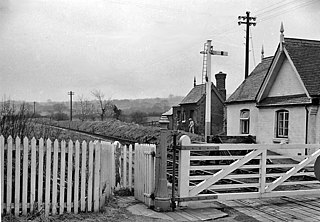
Biddulph railway station was a railway station opened by the North Staffordshire Railway in 1864. Originally named Gillow Heath the station was renamed Biddulph on 1 May 1897. The station was on the Biddulph Valley line that ran from a junction just north of Congleton on the Stoke-on-Trent – Macclesfield line to a junction south of Stoke-on-Trent station.
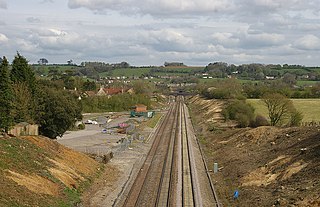
Chipping Sodbury railway station was a railway station on the South Wales Main Line serving the town of Chipping Sodbury in Gloucestershire.

Ram Hill is a hamlet in South Gloucestershire, England. It is located between Coalpit Heath and Westerleigh and adjoins the hamlet of Henfield immediately to the south. In the Mudge Map 1815, Ram Hill was known as Nutridge Hill, and was linked to Westerleigh by Broad Lane and to Mays Hill by Frog Lane.
The Bristol and Gloucestershire Railway was an early mineral railway, opened in two stages in 1832 and 1834, which connected collieries near Coalpit Heath with Bristol, at the river Avon. Horse traction was used. It was later taken over by the Bristol and Gloucester Railway, and much of the route became part of the main line between Birmingham and Bristol, though that was later by-passed and closed. Part of it now forms the Bristol and Bath Railway Path.

The Avon and Gloucestershire Railway also known as The Dramway was an early mineral railway, built to bring coal from pits in the Coalpit Heath area, north-east of Bristol, to the River Avon opposite Keynsham. It was dependent on another line for access to the majority of the pits, and after early success, bad relations and falling traffic potential dogged most of its existence.
The Badminton railway line is a railway line opened in 1903 by the Great Western Railway between the Great Western Main Line at Wootton Bassett in Wiltshire and Patchway and Filton, north of Bristol, England. Forming the eastern section of the South Wales Main Line, it shortened the distance between South Wales and London for heavy mineral traffic and for express passenger trains, and relieved congestion on the line through Bath.

Little Somerford railway station served the village of Little Somerford, Wiltshire, England from 1903 to 1962. It was on the South Wales Main Line and served as the junction for the Malmesbury branch line from 1933.

Hullavington railway station served the civil parish of Hullavington, Wiltshire, England from 1903 to 1965 on the South Wales Main Line.
